Magneto-Mechano-Electric (MME) Composite Devices for Energy Harvesting and Magnetic Field Sensing Applications
Abstract
:1. Introduction
2. High-Performance MME Composite Devices for Energy Harvesting and Magnetic Field Sensing Applications
2.1. Piezoelectric Single-Crystal Crystallographic Orientation for MME Harvesting
2.2. Effect of Dielectric and Mechanical Loss Factors on MME Harvesting
2.3. The Effect of Texturing of Magnetostrictive Phase O1n the Mme Harvesting Performance
2.4. Magnetic Flux Concentration Effect on Energy MME Harvesting Performance
2.5. Hybridization of Piezoelectric and Electromagnetic Induction Effects on MME Generator
2.6. Magneto-Mechano-Triboelectric Generator (MMTEG)
2.7. MMTEG for Optogenetic Neuromodulation
2.8. Ultra-Magnetic Field Sensitive MME Composite Enabled by Flash Photon Annealing
3. Conclusions
Author Contributions
Funding
Institutional Review Board Statement
Informed Consent Statement
Data Availability Statement
Conflicts of Interest
References
- Wang, Y.; Hu, J.; Lin, Y.; Nan, C.-W. Multiferroic Magnetoelectric Composite Nanostructures. NPG Asia Mater. 2010, 2, 61–68. [Google Scholar] [CrossRef] [Green Version]
- Priya, S.; Islam, R.; Dong, S.; Viehland, D. Recent Advancements in Magnetoelectric Particulate and Laminate Composites. J. Electroceramics 2007, 19, 149–166. [Google Scholar] [CrossRef]
- Palneedi, H.; Annapureddy, V.; Priya, S.; Ryu, J. Status and Perspectives of Multiferroic Magnetoelectric Composite Materials and Applications. Actuators 2016, 5, 9. [Google Scholar] [CrossRef] [Green Version]
- Nan, C.-W.; Bichurin, M.I.; Dong, S.; Viehland, D.; Srinivasan, G. Multiferroic Magnetoelectric Composites: Historical Perspective, Status, and Future Directions. J. Appl. Phys. 2008, 103, 31101. [Google Scholar] [CrossRef]
- Vaz, C.A.F.; Hoffman, J.; Ahn, C.H.; Ramesh, R. Magnetoelectric Coupling Effects in Multiferroic Complex Oxide Composite Structures. Adv. Mater. 2010, 22, 2900–2918. [Google Scholar] [CrossRef]
- Ryu, J.; Kang, J.-E.; Zhou, Y.; Choi, S.-Y.; Yoon, W.-H.; Park, D.-S.; Choi, J.-J.; Hahn, B.-D.; Ahn, C.-W.; Kim, J.-W.; et al. Ubiquitous Magneto-Mechano-Electric Generator. Energy Environ. Sci. 2015, 8, 2402–2408. [Google Scholar] [CrossRef]
- Lim, K.-W.; Peddigari, M.; Park, C.H.; Lee, H.Y.; Min, Y.; Kim, J.-W.; Ahn, C.-W.; Choi, J.-J.; Hahn, B.-D.; Choi, J.-H.; et al. A High Output Magneto-Mechano-Triboelectric Generator Enabled by Accelerated Water-Soluble Nano-Bullets for Powering a Wireless Indoor Positioning System. Energy Environ. Sci. 2019, 12, 666–674. [Google Scholar] [CrossRef]
- Annapureddy, V.; Kim, M.; Palneedi, H.; Lee, H.-Y.; Choi, S.-Y.; Yoon, W.-H.; Park, D.-S.; Choi, J.-J.; Hahn, B.-D.; Ahn, C.-W.; et al. Low-Loss Piezoelectric Single-Crystal Fibers for Enhanced Magnetic Energy Harvesting with Magnetoelectric Composite. Adv. Energy Mater. 2016, 6, 1601244. [Google Scholar] [CrossRef]
- Kwak, M.S.; Lim, K.-W.; Lee, H.Y.; Peddigari, M.; Jang, J.; Jeong, C.K.; Ryu, J.; Yoon, W.-H.; Yi, S.N.; Hwang, G.-T. Multiscale Surface Modified Magneto-Mechano-Triboelectric Nanogenerator Enabled by Eco-Friendly NaCl Imprinting Stamp for Self-Powered IoT Applications. Nanoscale 2021, 13, 8418–8424. [Google Scholar] [CrossRef] [PubMed]
- Kang, M.G.; Sriramdas, R.; Lee, H.; Chun, J.; Maurya, D.; Hwang, G.T.; Ryu, J.; Priya, S. High Power Magnetic Field Energy Harvesting through Amplified Magneto-Mechanical Vibration. Adv. Energy Mater. 2018, 8, 1703313. [Google Scholar] [CrossRef]
- Atzori, L.; Iera, A.; Morabito, G. The Internet of Things: A Survey. Comput. Networks 2010, 54, 2787–2805. [Google Scholar] [CrossRef]
- Gubbi, J.; Buyya, R.; Marusic, S.; Palaniswami, M. Internet of Things (IoT): A Vision, Architectural Elements, and Future Directions. Futur. Gener. Comput. Syst. 2013, 29, 1645–1660. [Google Scholar] [CrossRef] [Green Version]
- Haight, R.; Haensch, W.; Friedman, D. Solar-Powering the Internet of Things. Science 2016, 353, 124–125. [Google Scholar] [CrossRef]
- Hwang, G.-T.; Annapureddy, V.; Han, J.H.; Joe, D.J.; Baek, C.; Park, D.Y.; Kim, D.H.; Park, J.H.; Jeong, C.K.; Park, K.-I.; et al. Self-Powered Wireless Sensor Node Enabled by an Aerosol-Deposited PZT Flexible Energy Harvester. Adv. Energy Mater. 2016, 6, 1600237. [Google Scholar] [CrossRef]
- Lee, H.; Sriramdas, R.; Kumar, P.; Sanghadasa, M.; Kang, M.G.; Priya, S. Maximizing Power Generation from Ambient Stray Magnetic Fields around Smart Infrastructures Enabling Self-Powered Wireless Devices. Energy Environ. Sci. 2020, 13, 1462–1472. [Google Scholar] [CrossRef]
- Peddigari, M.; Woo, K.; Kim, S.-D.; Kwak, M.S.; Jeong, J.W.; Kang, J.-H.; Lee, S.-H.; Park, J.H.; Park, K.-I.; Annapureddy, V.; et al. Ultra-Magnetic Field Sensitive Magnetoelectric Composite with Sub-PT Detection Limit at Low Frequency Enabled by Flash Photon Annealing. Nano Energy 2021, 90, 106598. [Google Scholar] [CrossRef]
- Lyu, H.; Bae, Y.S.; Vijayakumaran Nair, V.; Choi, J.R. High Inductance Coil Embedded on On-Chip Magnetic Sensor for Biomagnetism Measurements. In Proceedings of the 2014 IEEE Sensors Applications Symposium (SAS), Queenstown, New Zealand, 18–20 February 2014; pp. 79–82. [Google Scholar]
- Cohen, D. Measurements of the Magnetic Fields Produced by the Human Heart, Brain, and Lungs. IEEE Trans. Magn. 1975, 11, 694–700. [Google Scholar] [CrossRef]
- Fagaly, R.L. Superconducting Quantum Interference Device Instruments and Applications. Rev. Sci. Instrum. 2006, 77, 101101. [Google Scholar] [CrossRef] [Green Version]
- Xi, H.; Qian, X.; Lu, M.-C.; Mei, L.; Rupprecht, S.; Yang, Q.X.; Zhang, Q.M. A Room Temperature Ultrasensitive Magnetoelectric Susceptometer for Quantitative Tissue Iron Detection. Sci. Rep. 2016, 6, 29740. [Google Scholar] [CrossRef] [Green Version]
- Annapureddy, V.; Palneedi, H.; Yoon, W.-H.; Park, D.-S.; Choi, J.-J.; Hahn, B.-D.; Ahn, C.-W.; Kim, J.-W.; Jeong, D.-Y.; Ryu, J. A PT/√Hz Sensitivity Ac Magnetic Field Sensor Based on Magnetoelectric Composites Using Low-Loss Piezoelectric Single Crystals. Sens. Actuators A Phys. 2017, 260, 206–211. [Google Scholar] [CrossRef]
- Chu, Z.; Shi, H.; Shi, W.; Liu, G.; Wu, J.; Yang, J.; Dong, S. Enhanced Resonance Magnetoelectric Coupling in (1–1) Connectivity Composites. Adv. Mater. 2017, 29, 1606022. [Google Scholar] [CrossRef] [PubMed]
- Chu, Z.; Shi, W.; Shi, H.; Chen, Q.; Wang, L.; PourhosseiniAsl, M.J.; Xiao, C.; Xie, T.; Dong, S. A 1D Magnetoelectric Sensor Array for Magnetic Sketching. Adv. Mater. Technol. 2019, 4, 1800484. [Google Scholar] [CrossRef]
- Kambale, R.C.; Yoon, W.-H.; Park, D.-S.; Choi, J.-J.; Ahn, C.-W.; Kim, J.-W.; Hahn, B.-D.; Jeong, D.-Y.; Lee, B.C.B.; Chung, G.-S.; et al. Magnetoelectric Properties and Magnetomechanical Energy Harvesting from Stray Vibration and Electromagnetic Wave by Pb(Mg1/3Nb2/3)O3-Pb(Zr,Ti)O3 Single Crystal/Ni Cantilever. J. Appl. Phys. 2013, 113, 204108. [Google Scholar] [CrossRef]
- Ma, J.; Hu, J.; Li, Z.; Nan, C.-W. Recent Progress in Multiferroic Magnetoelectric Composites: From Bulk to Thin Films. Adv. Mater. 2011, 23, 1062–1087. [Google Scholar] [CrossRef]
- IEEE 1859-2017; IEEE Standard for Relaxor-Based Single Crystals for Transducer and Actuator Application. IEEE: Piscataway, NJ, USA, 2006.
- Park, S.-E.; Shrout, T.R. Ultrahigh Strain and Piezoelectric Behavior in Relaxor Based Ferroelectric Single Crystals. J. Appl. Phys. 1997, 82, 1804–1811. [Google Scholar] [CrossRef]
- Rajaram Patil, D.; Chai, Y.; Kambale, R.C.; Jeon, B.-G.; Yoo, K.; Ryu, J.; Yoon, W.-H.; Park, D.-S.; Jeong, D.-Y.; Lee, S.-G.; et al. Enhancement of Resonant and Non-Resonant Magnetoelectric Coupling in Multiferroic Laminates with Anisotropic Piezoelectric Properties. Appl. Phys. Lett. 2013, 102, 62909. [Google Scholar] [CrossRef]
- Fu, H.; Cohen, R.E. Polarization Rotation Mechanism for Ultrahigh Electromechanical Response in Single-Crystal Piezoelectrics. Nature 2000, 403, 281–283. [Google Scholar] [CrossRef]
- Sun, E.; Cao, W. Relaxor-Based Ferroelectric Single Crystals: Growth, Domain Engineering, Characterization and Applications. Prog. Mater. Sci. 2014, 65, 124–210. [Google Scholar] [CrossRef] [Green Version]
- Cowley, R.A.; Gvasaliya, S.N.; Lushnikov, S.G.; Roessli, B.; Rotaru, G.M. Relaxing with Relaxors: A Review of Relaxor Ferroelectrics. Adv. Phys. 2011, 60, 229–327. [Google Scholar] [CrossRef]
- Zhang, S.; Zhao, Y.; Xiao, X.; Wu, Y.; Rizwan, S.; Yang, L.; Li, P.; Wang, J.; Zhu, M.; Zhang, H.; et al. Giant Electrical Modulation of Magnetization in Co40Fe40B20/Pb(Mg1/3Nb2/3)0.7Ti0.3O3 (011) Heterostructure. Sci. Rep. 2014, 4, 3727. [Google Scholar] [CrossRef] [Green Version]
- Palneedi, H.; Annapureddy, V.; Lee, H.-Y.; Choi, J.-J.; Choi, S.-Y.; Chung, S.-Y.; Kang, S.-J.L.; Ryu, J. Strong and Anisotropic Magnetoelectricity in Composites of Magnetostrictive Ni and Solid-State Grown Lead-Free Piezoelectric BZT–BCT Single Crystals. J. Asian Ceram. Soc. 2017, 5, 36–41. [Google Scholar] [CrossRef] [Green Version]
- Usman, K.; Abu-Dieyeh, M.H.; Zouari, N.; Al-Ghouti, M.A. Lead (Pb) Bioaccumulation and Antioxidative Responses in Tetraena Qataranse. Sci. Rep. 2020, 10, 17070. [Google Scholar] [CrossRef] [PubMed]
- Maurya, D.; Peddigari, M.; Kang, M.-G.; Geng, L.D.; Sharpes, N.; Annapureddy, V.; Palneedi, H.; Sriramdas, R.; Yan, Y.; Song, H.-C.; et al. Lead-Free Piezoelectric Materials and Composites for High Power Density Energy Harvesting. J. Mater. Res. 2018, 33, 2235–2263. [Google Scholar] [CrossRef] [Green Version]
- Roscow, J.I.; Lewis, R.W.C.; Taylor, J.; Bowen, C.R. Modelling and Fabrication of Porous Sandwich Layer Barium Titanate with Improved Piezoelectric Energy Harvesting Figures of Merit. Acta Mater. 2017, 128, 207–217. [Google Scholar] [CrossRef]
- Cho, K.-H.; Park, C.-S.; Priya, S. Effect of Intensive and Extensive Loss Factors on the Dynamic Response of Magnetoelectric Laminates. Appl. Phys. Lett. 2010, 97, 182902. [Google Scholar] [CrossRef] [Green Version]
- Ryu, J.; Priya, S.; Uchino, K.; Kim, H.-E. Magnetoelectric Effect in Composites of Magnetostrictive and Piezoelectric Materials. J. Electroceramics 2002, 8, 107–119. [Google Scholar] [CrossRef]
- Yang, Z.; Zu, J. Comparison of PZN-PT, PMN-PT Single Crystals and PZT Ceramic for Vibration Energy Harvesting. Energy Convers. Manag. 2016, 122, 321–329. [Google Scholar] [CrossRef]
- Kambale, R.C.; Kang, J.-E.; Yoon, W.-H.; Park, D.-S.; Choi, J.-J.; Ahn, C.-W.; Kim, J.-W.; Hahn, B.-D.; Jeong, D.-Y.; Kim, Y.-D.; et al. Magneto-Mechano-Electric (MME) Energy Harvesting Properties of Piezoelectric Macro-Fiber Composite/Ni Magnetoelectric Generator. Energy Harvest. Syst. 2014, 1, 3–11. [Google Scholar] [CrossRef]
- Annapureddy, V.; Palneedi, H.; Hwang, G.-T.; Peddigari, M.; Jeong, D.-Y.; Yoon, W.-H.; Kim, K.-H.; Ryu, J. Magnetic Energy Harvesting with Magnetoelectrics: An Emerging Technology for Self-Powered Autonomous Systems. Sustain. Energy Fuels 2017, 1, 2039–2052. [Google Scholar] [CrossRef]
- Jerems, F.; Mahon, C.M.; Jenner, A.G.; Greenough, R.D. Amorphous Magnetic Materials for Transducers. Ferroelectrics 1999, 228, 333–341. [Google Scholar] [CrossRef]
- Wang, H.; Zhang, Y.N.; Wu, R.Q.; Sun, L.Z.; Xu, D.S.; Zhang, Z.D. Understanding Strong Magnetostriction in Fe100−xGax Alloys. Sci. Rep. 2013, 3, 3521. [Google Scholar] [CrossRef] [Green Version]
- Annapureddy, V.; Na, S.-M.; Hwang, G.-T.; Kang, M.G.; Sriramdas, R.; Palneedi, H.; Yoon, W.-H.; Hahn, B.-D.; Kim, J.-W.; Ahn, C.-W.; et al. Exceeding Milli-Watt Powering Magneto-Mechano-Electric Generator for Standalone-Powered Electronics. Energy Environ. Sci. 2018, 11, 818–829. [Google Scholar] [CrossRef]
- Song, H.-C.; Kim, S.-W.; Kim, H.S.; Lee, D.-G.; Kang, C.-Y.; Nahm, S. Piezoelectric Energy Harvesting Design Principles for Materials and Structures: Material Figure-of-Merit and Self-Resonance Tuning. Adv. Mater. 2020, 32, 2002208. [Google Scholar] [CrossRef]
- Zhou, Y.; Apo, D.J.; Priya, S. Dual-Phase Self-Biased Magnetoelectric Energy Harvester. Appl. Phys. Lett. 2013, 103, 192909. [Google Scholar] [CrossRef] [Green Version]
- Song, H.-C.; Kumar, P.; Sriramdas, R.; Lee, H.; Sharpes, N.; Kang, M.-G.; Maurya, D.; Sanghadasa, M.; Kang, H.-W.; Ryu, J.; et al. Broadband Dual Phase Energy Harvester: Vibration and Magnetic Field. Appl. Energy 2018, 225, 1132–1142. [Google Scholar] [CrossRef]
- Chu, Z.; Annapureddy, V.; PourhosseiniAsl, M.; Palneedi, H.; Ryu, J.; Dong, S. Dual-Stimulus Magnetoelectric Energy Harvesting. MRS Bull. 2018, 43, 199–205. [Google Scholar] [CrossRef]
- Zhang, Y.; Liu, G.; Shi, H.; Xiao, W.; Zhu, Y.; Li, M.; Li, M.; Liu, J. Enhanced Magnetoelectric Effect in Ferromagnetic–Elastic–Piezoelectric Composites. J. Alloys Compd. 2014, 613, 93–95. [Google Scholar] [CrossRef]
- Patil, D.R.; Zhou, Y.; Kang, J.-E.; Sharpes, N.; Jeong, D.-Y.; Kim, Y.-D.; Kim, K.H.; Priya, S.; Ryu, J. Anisotropic Self-Biased Dual-Phase Low Frequency Magneto-Mechano-Electric Energy Harvesters with Giant Power Densities. APL Mater. 2014, 2, 46102. [Google Scholar] [CrossRef]
- Sriramdas, R.; Kang, M.-G.; Meng, M.; Kiani, M.; Ryu, J.; Sanghadasa, M.; Priya, S. Large Power Amplification in Magneto-Mechano-Electric Harvesters through Distributed Forcing. Adv. Energy Mater. 2020, 10, 1903689. [Google Scholar] [CrossRef]
- Annapureddy, V.; Lee, H.Y.; Yoon, W.-H.; Woo, H.-J.; Lee, J.-H.; Palneedi, H.; Kim, H.-J.; Choi, J.-J.; Jeong, D.-Y.; Yi, S.N.; et al. Enhanced Magnetic Energy Harvesting Properties of Magneto-Mechano-Electric Generator by Tailored Geometry. Appl. Phys. Lett. 2016, 109, 93901. [Google Scholar] [CrossRef]
- Song, H.; Patil, D.R.; Yoon, W.-H.; Kim, K.-H.; Choi, C.; Kim, J.-H.; Hwang, G.-T.; Jeong, D.-Y.; Ryu, J. Significant Power Enhancement of Magneto-Mechano-Electric Generators by Magnetic Flux Concentration. Energy Environ. Sci. 2020, 13, 4238–4248. [Google Scholar] [CrossRef]
- Choi, H.S.; Annapureddy, V.; Park, N.; Jeong, J.-W.; Hwang, G.-T.; Ryu, J. High-Performance Magneto-Mechano-Electric Generator through Optimization of Magnetic Flux Concentration. Sustain. Energy Fuels 2022, 6, 2700–2708. [Google Scholar] [CrossRef]
- Thunderboard Sense 2 Sensor-to-Cloud Advanced IoT Kits—Silconlabs. Available online: https://www.silabs.com/development-tools/thunderboard/thunderboard-sense-two-kit (accessed on 2 May 2022).
- Jung, I.; Choi, J.; Park, H.-J.; Lee, T.-G.; Nahm, S.; Song, H.-C.; Kim, S.; Kang, C.-Y. Design Principles for Coupled Piezoelectric and Electromagnetic Hybrid Energy Harvesters for Autonomous Sensor Systems. Nano Energy 2020, 75, 104921. [Google Scholar] [CrossRef]
- Wen, Z.; Guo, H.; Zi, Y.; Yeh, M.-H.; Wang, X.; Deng, J.; Wang, J.; Li, S.; Hu, C.; Zhu, L.; et al. Harvesting Broad Frequency Band Blue Energy by a Triboelectric–Electromagnetic Hybrid Nanogenerator. ACS Nano 2016, 10, 6526–6534. [Google Scholar] [CrossRef]
- Zhang, K.; Wang, Y.; Yang, Y. Structure Design and Performance of Hybridized Nanogenerators. Adv. Funct. Mater. 2019, 29, 1806435. [Google Scholar] [CrossRef]
- Kwak, M.S.; Peddigari, M.; Lee, H.Y.; Min, Y.; Park, K.-I.; Kim, J.-H.; Yoon, W.-H.; Ryu, J.; Yi, S.N.; Jang, J.; et al. Exceeding 50 MW RMS-Output Magneto-Mechano-Electric Generator by Hybridizing Piezoelectric and Electromagnetic Induction Effects. Adv. Funct. Mater. 2022, 32, 2112028. [Google Scholar] [CrossRef]
- Wang, Z.L.; Chen, J.; Lin, L. Progress in Triboelectric Nanogenerators as a New Energy Technology and Self-Powered Sensors. Energy Environ. Sci. 2015, 8, 2250–2282. [Google Scholar] [CrossRef]
- Tønnesen, J.; Sørensen, A.T.; Deisseroth, K.; Lundberg, C.; Kokaia, M. Optogenetic Control of Epileptiform Activity. Proc. Natl. Acad. Sci. USA 2009, 106, 12162–12167. [Google Scholar] [CrossRef] [Green Version]
- Gradinaru, V.; Mogri, M.; Thompson, K.R.; Henderson, J.M.; Deisseroth, K. Optical Deconstruction of Parkinsonian Neural Circuitry. Science 2009, 324, 354–359. [Google Scholar] [CrossRef] [Green Version]
- Lee, S.H.; Kim, J.; Shin, J.H.; Lee, H.E.; Kang, I.-S.; Gwak, K.; Kim, D.-S.; Kim, D.; Lee, K.J. Optogenetic Control of Body Movements via Flexible Vertical Light-Emitting Diodes on Brain Surface. Nano Energy 2018, 44, 447–455. [Google Scholar] [CrossRef]
- Hwang, G.-T.; Kim, Y.; Lee, J.-H.; Oh, S.; Jeong, C.K.; Park, D.Y.; Ryu, J.; Kwon, H.; Lee, S.-G.; Joung, B.; et al. Self-Powered Deep Brain Stimulation via a Flexible PIMNT Energy Harvester. Energy Environ. Sci. 2015, 8, 2677–2684. [Google Scholar] [CrossRef]
- Zhao, Y.; Liu, C.; Liu, Z.; Luo, W.; Li, L.; Cai, X.; Liang, D.; Su, Y.; Ding, H.; Wang, Q.; et al. Wirelessly Operated, Implantable Optoelectronic Probes for Optogenetics in Freely Moving Animals. IEEE Trans. Electron Devices 2019, 66, 785–792. [Google Scholar] [CrossRef]
- Lee, H.E.; Park, J.H.; Jang, D.; Shin, J.H.; Im, T.H.; Lee, J.H.; Hong, S.K.; Wang, H.S.; Kwak, M.S.; Peddigari, M.; et al. Optogenetic Brain Neuromodulation by Stray Magnetic Field via Flash-Enhanced Magneto-Mechano-Triboelectric Nanogenerator. Nano Energy 2020, 75, 104951. [Google Scholar] [CrossRef]
- Wang, Y.; Li, J.; Viehland, D. A Differential Magnetoelectric Heterostructure: Internal Noise Reduction and External Noise Cancellation. J. Appl. Phys. 2015, 118, 214103. [Google Scholar]
- Kim, S.; Vyas, R.; Bito, J.; Niotaki, K.; Collado, A.; Georgiadis, A.; Tentzeris, M.M. Ambient RF Energy-Harvesting Technologies for Self-Sustainable Standalone Wireless Sensor Platforms. Proc. IEEE 2014, 102, 1649–1666. [Google Scholar] [CrossRef]
- Liu, Z.; Zhong, Z.; Guo, Y.-X. Enhanced Dual-Band Ambient RF Energy Harvesting with Ultra-Wide Power Range. IEEE Microw. Wirel. Components Lett. 2015, 25, 630–632. [Google Scholar] [CrossRef]
- Hagerty, J.A.; Helmbrecht, F.B.; McCalpin, W.H.; Zane, R.; Popovic, Z.B. Recycling Ambient Microwave Energy with Broad-Band Rectenna Arrays. IEEE Trans. Microw. Theory Tech. 2004, 52, 1014–1024. [Google Scholar] [CrossRef]
- Rashidi, S.; Ehsani, M.H.; Shakouri, M.; Karimi, N. Potentials of Magnetic Shape Memory Alloys for Energy Harvesting. J. Magn. Magn. Mater. 2021, 537, 168112. [Google Scholar] [CrossRef]


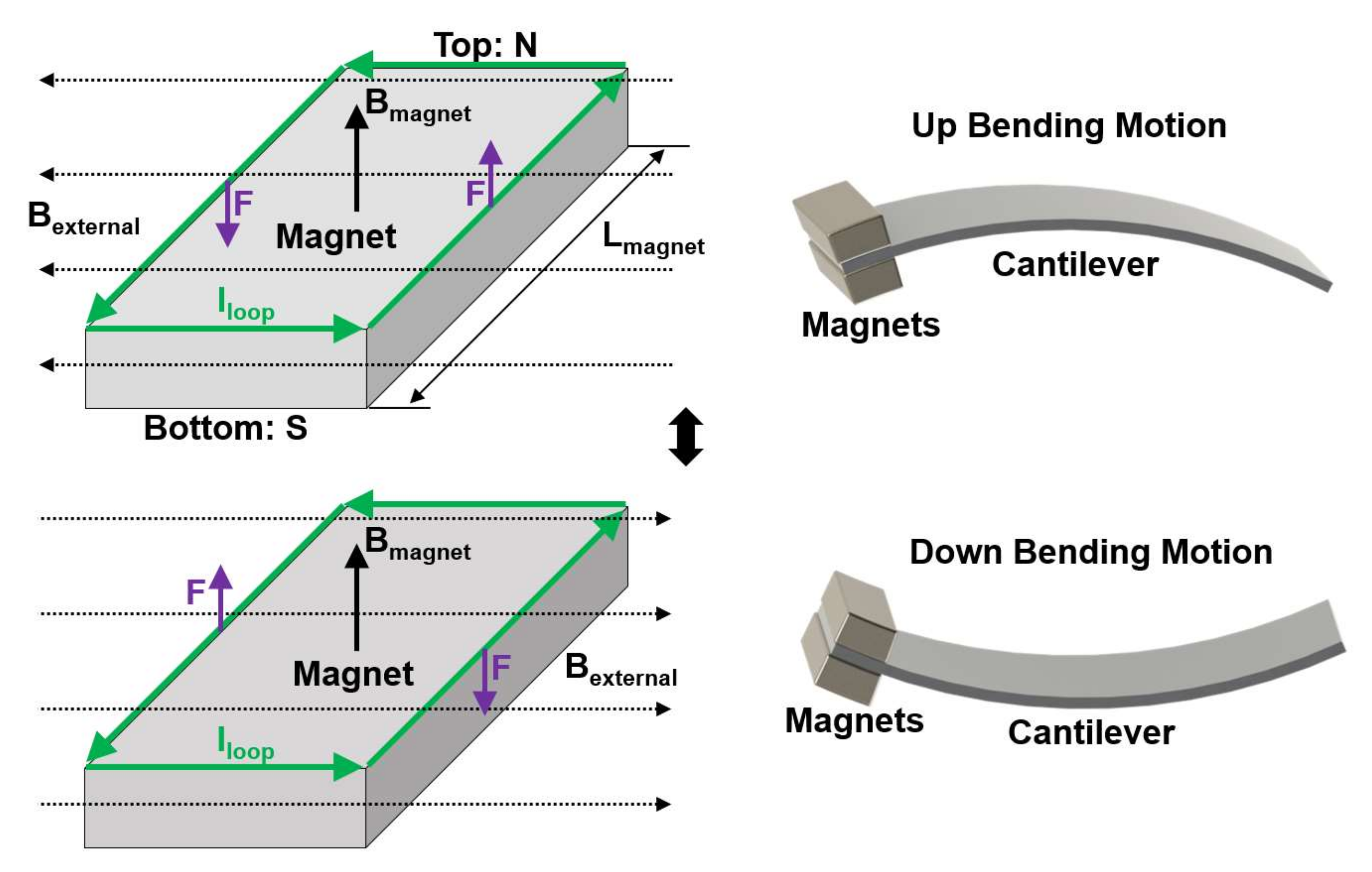


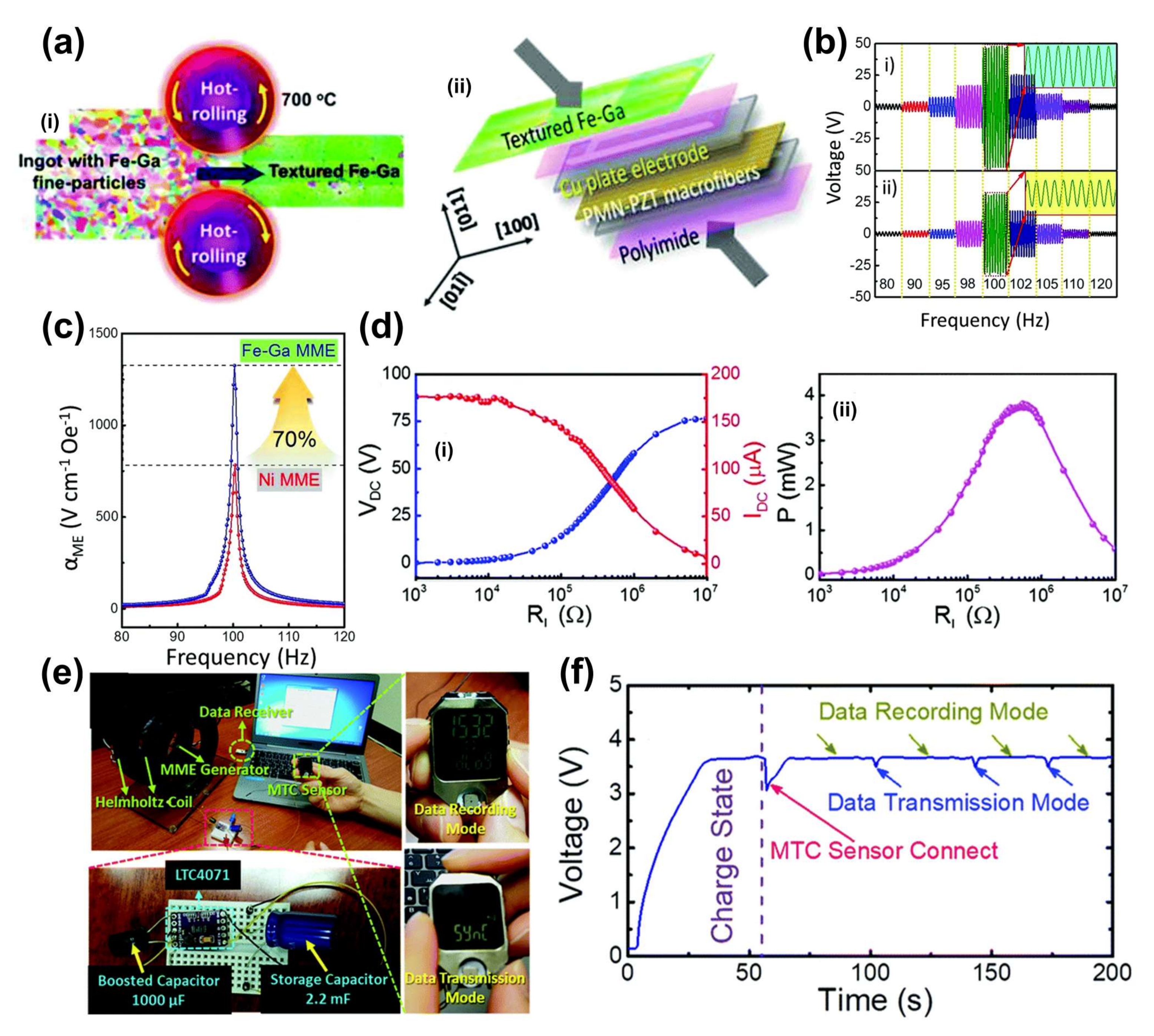
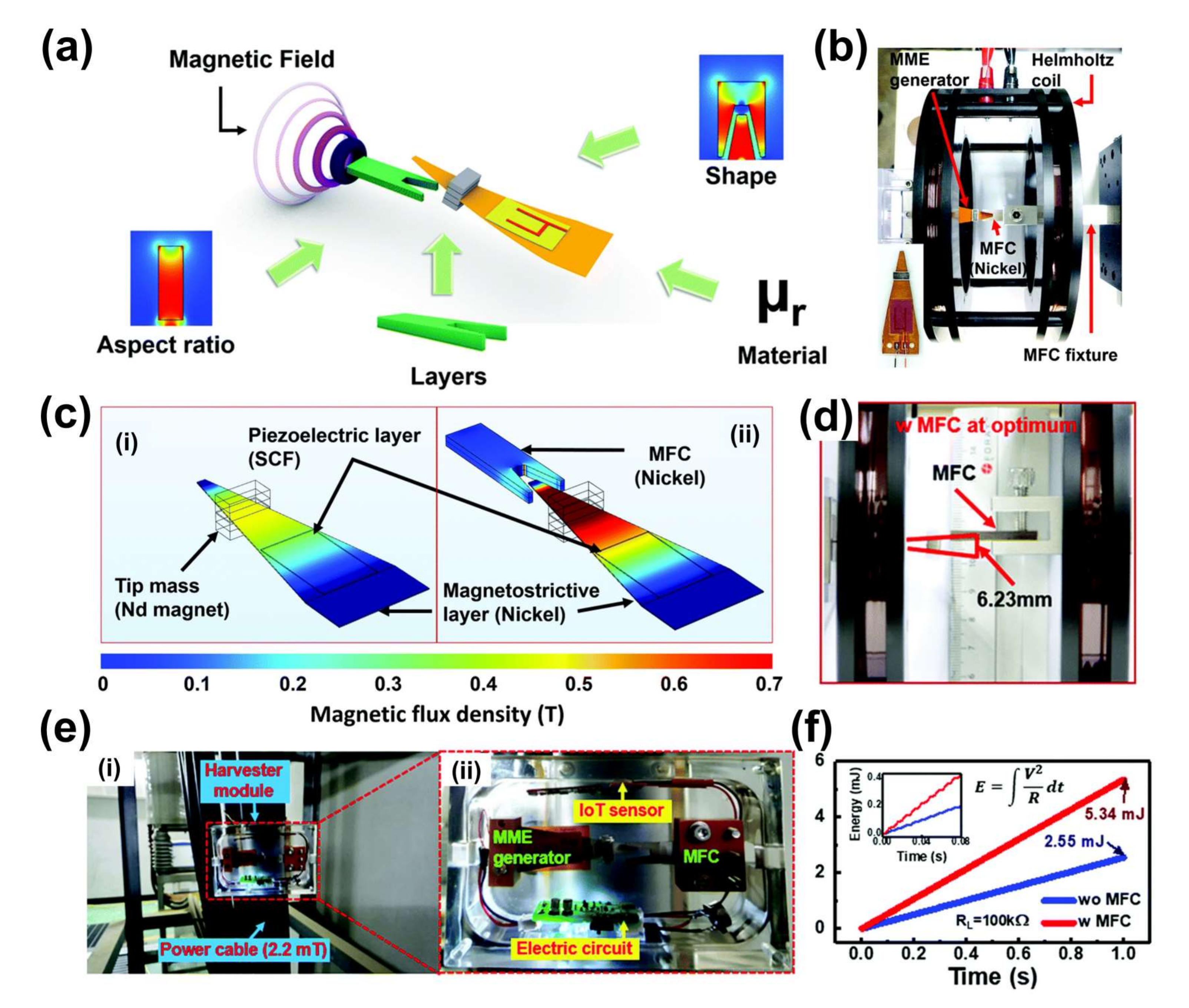
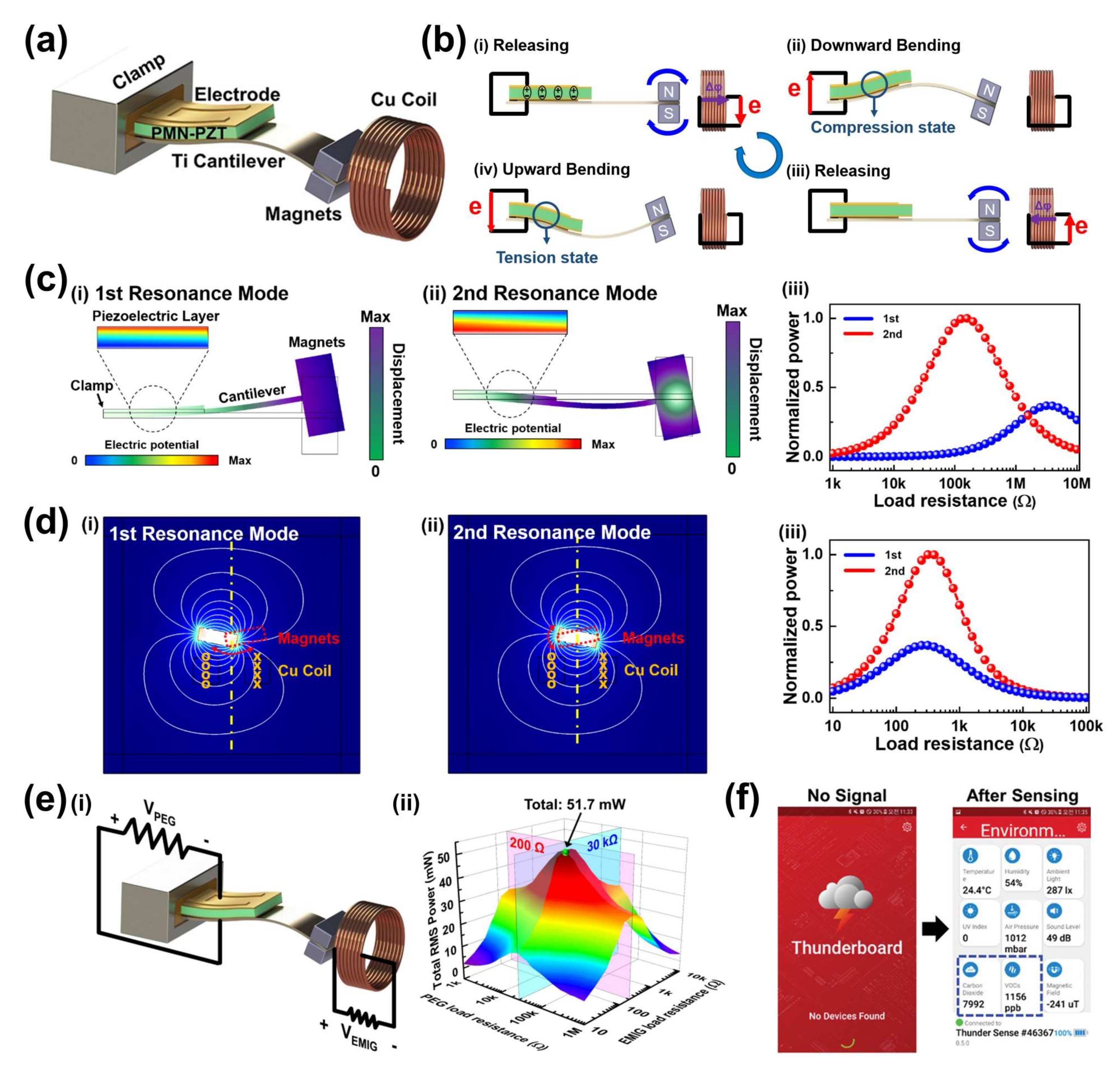
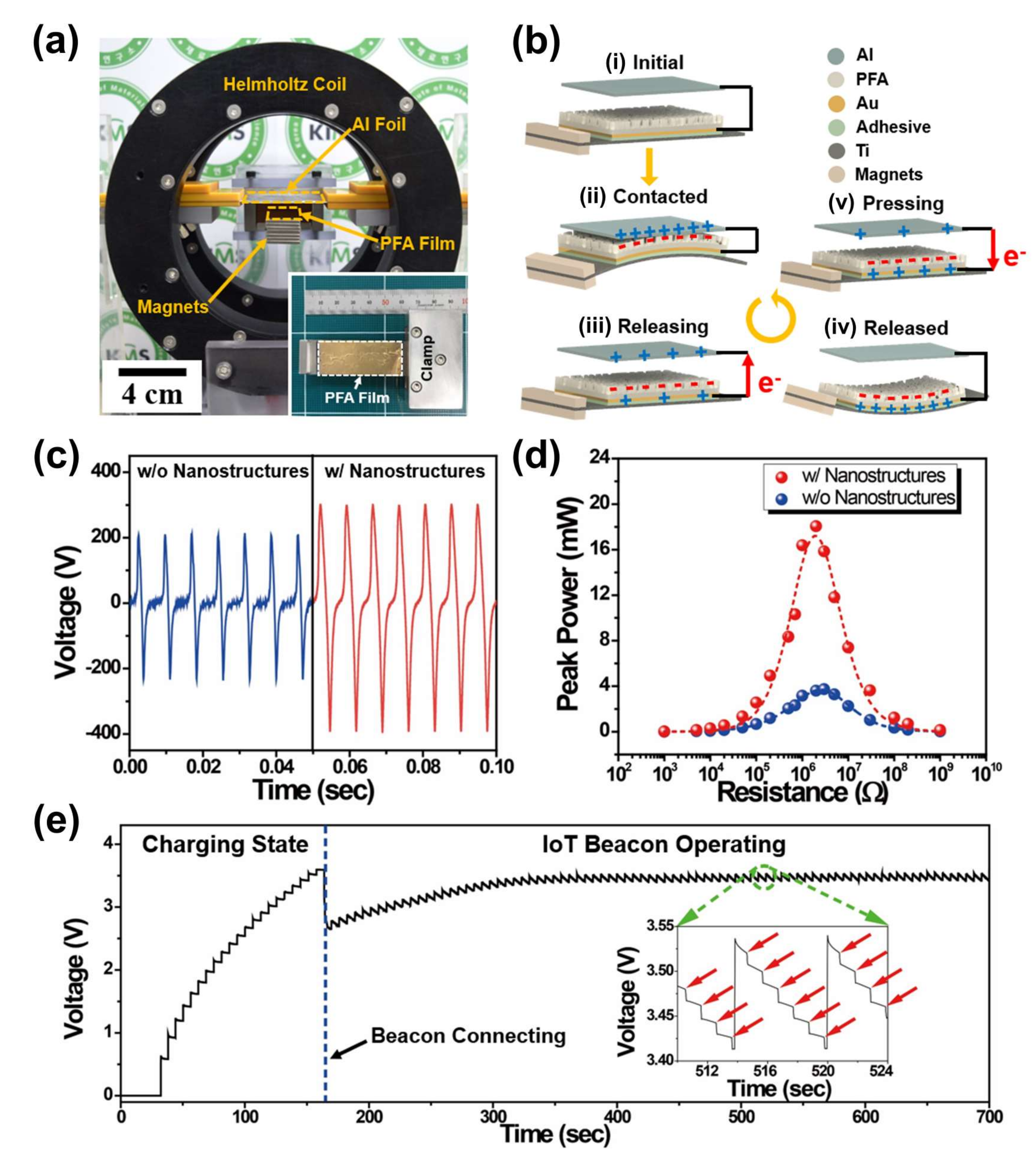

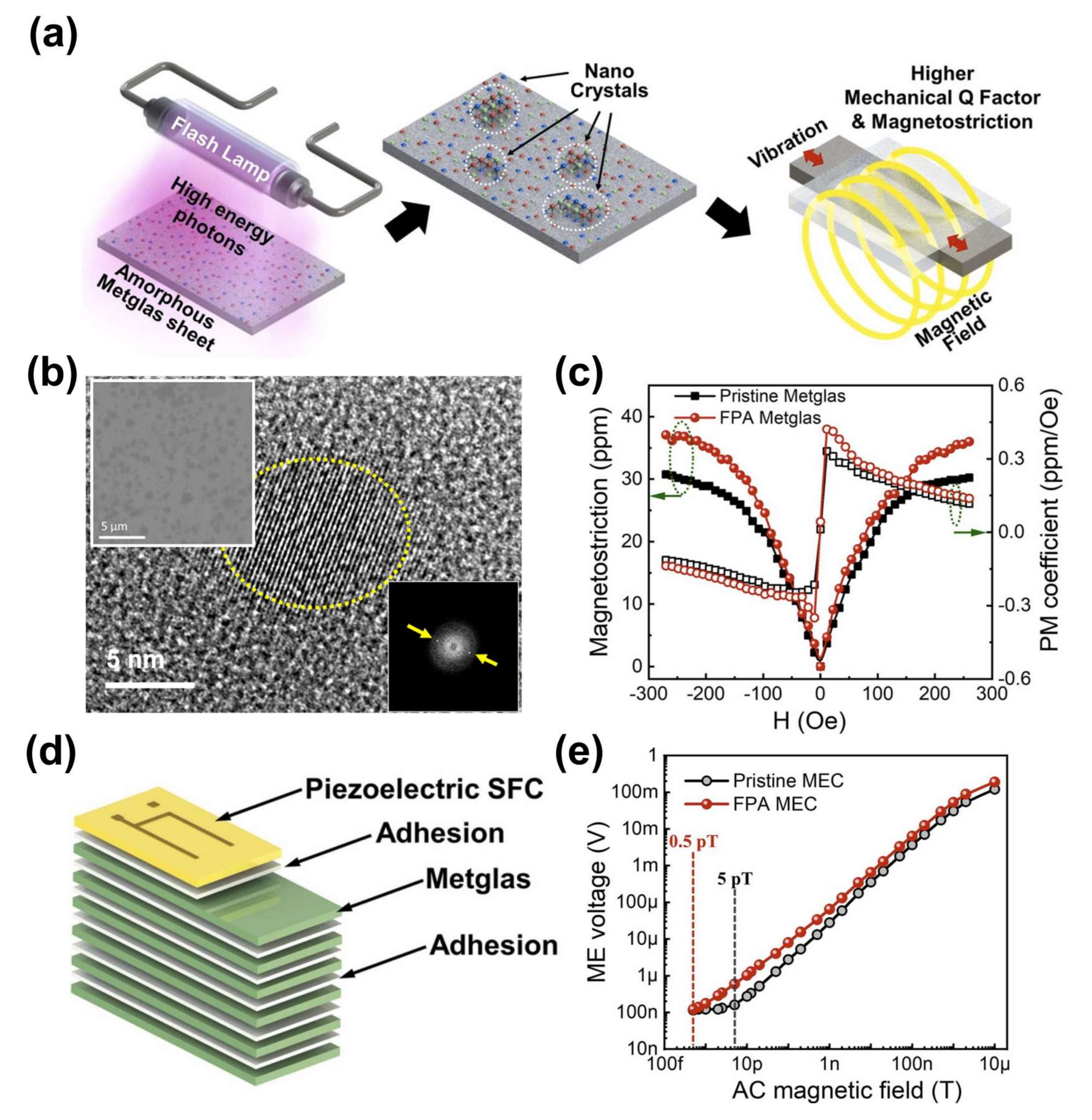

Publisher’s Note: MDPI stays neutral with regard to jurisdictional claims in published maps and institutional affiliations. |
© 2022 by the authors. Licensee MDPI, Basel, Switzerland. This article is an open access article distributed under the terms and conditions of the Creative Commons Attribution (CC BY) license (https://creativecommons.org/licenses/by/4.0/).
Share and Cite
Pattipaka, S.; Jeong, J.; Choi, H.; Ryu, J.; Hwang, G.-T. Magneto-Mechano-Electric (MME) Composite Devices for Energy Harvesting and Magnetic Field Sensing Applications. Sensors 2022, 22, 5723. https://doi.org/10.3390/s22155723
Pattipaka S, Jeong J, Choi H, Ryu J, Hwang G-T. Magneto-Mechano-Electric (MME) Composite Devices for Energy Harvesting and Magnetic Field Sensing Applications. Sensors. 2022; 22(15):5723. https://doi.org/10.3390/s22155723
Chicago/Turabian StylePattipaka, Srinivas, Jaewon Jeong, Hyunsu Choi, Jungho Ryu, and Geon-Tae Hwang. 2022. "Magneto-Mechano-Electric (MME) Composite Devices for Energy Harvesting and Magnetic Field Sensing Applications" Sensors 22, no. 15: 5723. https://doi.org/10.3390/s22155723
APA StylePattipaka, S., Jeong, J., Choi, H., Ryu, J., & Hwang, G.-T. (2022). Magneto-Mechano-Electric (MME) Composite Devices for Energy Harvesting and Magnetic Field Sensing Applications. Sensors, 22(15), 5723. https://doi.org/10.3390/s22155723





